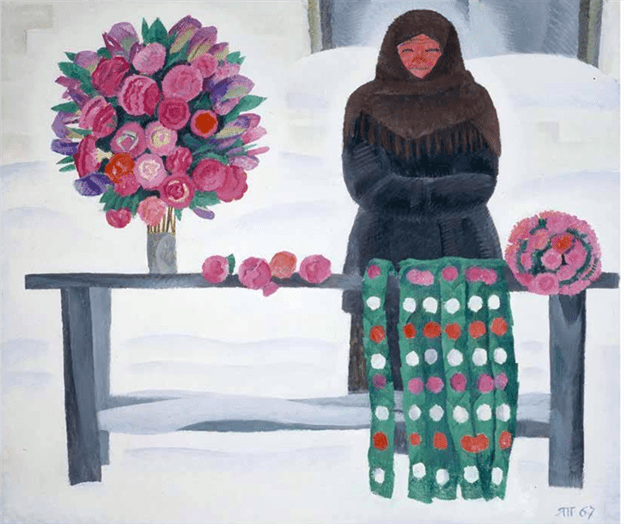
 Claire Wortsman is an IPilogue Senior Editor and a 2L JD Candidate at Osgoode Hall Law School.
Claire Wortsman is an IPilogue Senior Editor and a 2L JD Candidate at Osgoode Hall Law School.
On International Women’s Day in Odessa, Ukraine, soldiers bought friends and family flowers despite the fear of an imminent Russian attack. Soldier Dmitriy bought pink and yellow tulips for female soldiers, while flower vendor Alena tied a bouquet of blue and yellow tulips in honour of the Ukrainian colours. Flowers hold a special place in Ukrainian cultural heritage, which now faces risk of destruction.
On March 1, invading Russian forces shelled Babi Yar (Babyn Yar)—a Nazi killing ground where thousands of Jews, Romani people, psychiatric patients, and war prisoners were massacred. The shelling killed at least five people, and injured another five. While the Babyn Yar Holocaust Memorial Center was not directly damaged, the center had plans to expand to a nearby building that suffered damage in the bombing.
In the wake of destruction and killing at the symbolic site, President Zelenskyy said, “[the Russian invaders] all have orders to erase our history, erase our country, erase us all.” It is important to understand and celebrate Ukrainian history and culture more than ever. Every day, especially during Women’s History Month, it is also essential to understand and celebrate women’s contributions to the foundations of history and culture.
Flowers and Female Ukrainian Artists
The United Nations Educational, Scientific and Cultural Organization (UNESCO) has recognized the Petrykivka decorative painting as a valuable part of humanity’s intangible cultural heritage. Petrykivka is named for Petrykivka village, where the Ukrainian Zaporizhian Cossack practice of decorating living quarters and belongings with fantastic flowers and natural elements was miraculously preserved despite the brutal Soviet regime. A local non-governmental organization, Agency for Regional Development of Dnipropetrovsk Region, secured the Petrykivka trademark.
Believed to protect the wearer from sorrow and evil, flower ornaments in the Petrykivka style were typically applied by women of all ages. Tetiana Pata, Nadia Bilokin, Paraska Pavlenko, Iryna Pylypenko, and Pelaheia Hlushchenko are known as the “founding mothers” of the transformative period of Petrykivka art where local artists integrated the style to their traditional mediums following its re-discovery. The many talented Ukrainian female artists that have emerged throughout history have carved out their unique styles. Still, many have integrated uniquely Ukrainian elements of Petrykivka into their work, whether in the form of vibrant flora or fantastical fauna.
Petrykivka can transform everyday objects into art. During summers spent with her great-grandmother in Poltava, a Ukrainian village north of Petrykivka, Victoria recalls dishes, vases, and kettles adorned with clusters of red guelder rose berries and orange flowers. Like Petrykivka artists, Odessa-born Tatiana Bolokonenko does not restrict herself to canvass. She is known for her wall paintings and has also created pieces reminiscent of Petrykivka—accessories like handbags and wallets adorned with lively flora. Energetic florals are also alive in Olesya Hudyma, whose work also features the poignant Angels of Peace for Ukraine.
Daria Dorosh, an original member of Artists in Residence (A.I.R.) Gallery—the first artist-run, not-for-profit gallery dedicated to women and non-binary artists in the USA—is another Ukrainian artist whose work features flowers. Dorosh repurposes fabric and textile work, a traditionally female craft, to explore complex topics such as the slippage of play between childhood and adulthood. Textile work was an important feature of Sonia Delaunay’s art. For example, Design 1044 (1931) is a fabric sample where overlapping oblong shapes of varying blues, greens, and yellows resemble a collection of flower petals.
A discussion of flowers and female Ukrainian artists would be incomplete without Kateryna Bilokur, the self-taught painter of floral scenes who made Picasso remark, “if we had an artist of this level of skill, we would make the whole world talk about her.” Bilokur’s Happiness, Storks brought the baby (1950) features sunflowers. As Ukraine’s national flower, the sunflower has quickly become a symbol of resistance. Sunflowers have inspired Ukrainian artists from Maria Prymachenko to Alina Panova to Natasha Zinko, each in their unique way.
The magical and bright flora featured in Ukrainian female artists’ work throughout history provides a stark contrast to the images coming out of Ukraine in recent weeks. As Ukraine’s humanitarian crisis continues during Women’s History Month, the comments of European Parliament President Roberta Metsola remain on my mind. He commended the “incredibly brave women of Ukraine who are fighting, forced to shelter their loved ones in bunkers, giving birth in metro stations and leading on the frontline.” On my mind, too, are the Ukrainian women who have built up the intangible cultural heritage of humanity and their images of strength, hope, and peace.